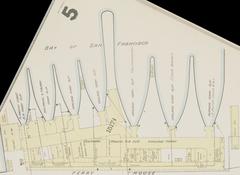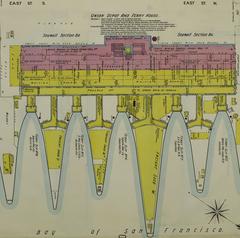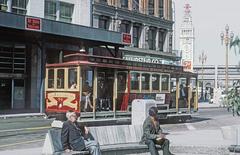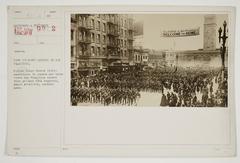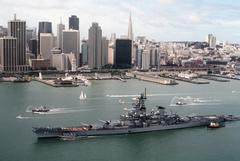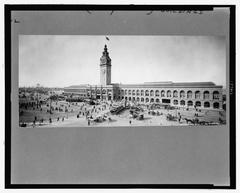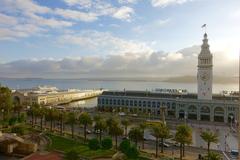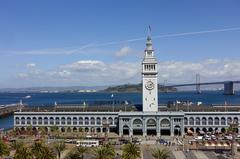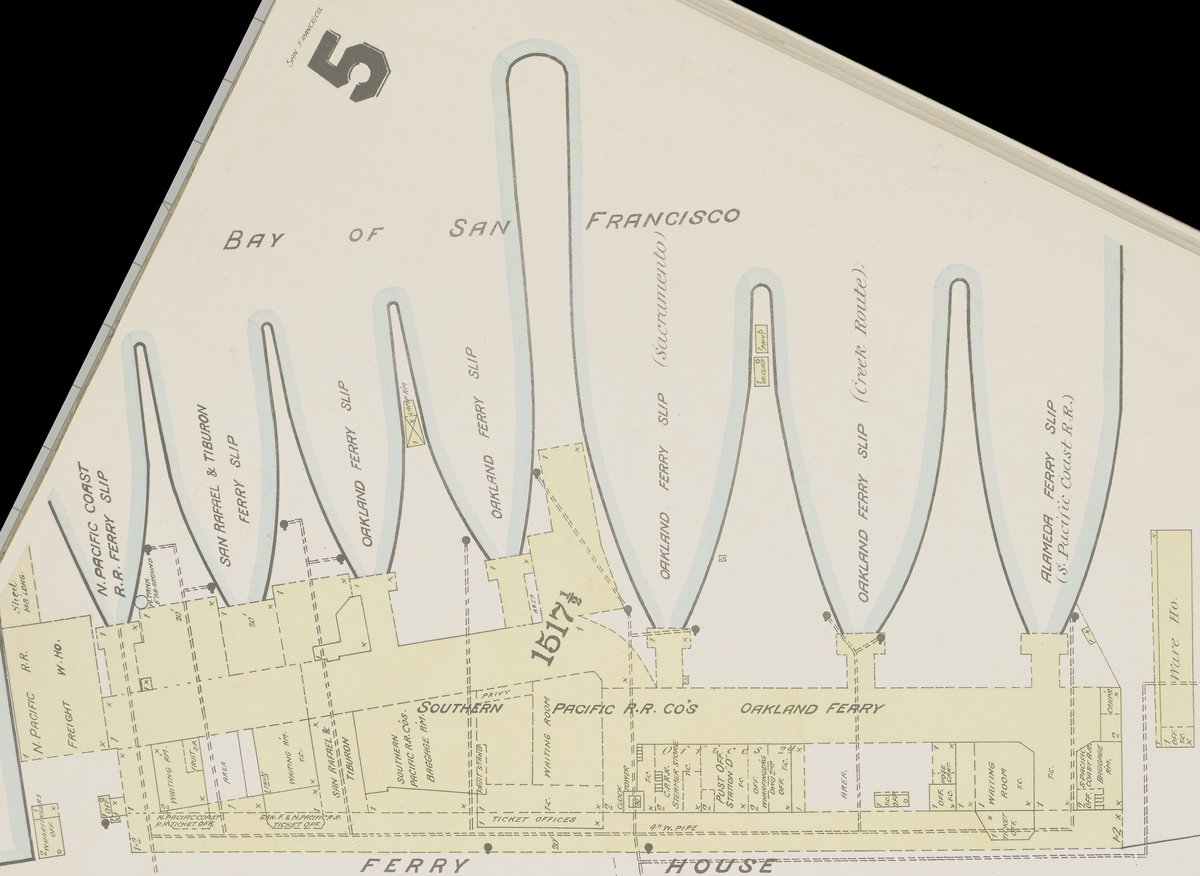
San Francisco Ferry Building Visiting Hours Tickets and Travel Guide
Date: 14/06/2025
Introduction to the San Francisco Ferry Building and What Visitors Can Expect
The San Francisco Ferry Building stands as one of the city’s most iconic landmarks, seamlessly blending rich historical significance, architectural grandeur, and vibrant contemporary culture. Situated at the foot of Market Street along the Embarcadero, this Beaux-Arts masterpiece, designed by A. Page Brown and completed in 1898, originally functioned as a bustling transportation hub connecting San Francisco to the East Bay, Marin, and beyond. Before the era of the Bay and Golden Gate Bridges, the Ferry Building was the primary gateway for tens of thousands of commuters and travelers daily, symbolizing the city’s maritime heritage and economic growth (Wikipedia; Urban Land Institute PDF).
Its commanding 245-foot clock tower, inspired by the Giralda bell tower in Seville, Spain, is a distinctive element of San Francisco’s skyline, visible for miles and emblematic of the city’s resilience and history (Secret San Francisco). The building’s robust steel and concrete structure has withstood major earthquakes, including those in 1906 and 1989, underscoring its engineering significance.
Following decades of decline due to the rise of automobile travel and the construction of bridges, the Ferry Building underwent a transformative restoration completed in 2003. This adaptive reuse project revitalized the Grand Nave and transformed the space into a lively marketplace showcasing local artisan foods, shops, and the renowned Ferry Plaza Farmers Market, which draws visitors from across the Bay Area (Ferry Building Marketplace; SF Tourism Tips).
Today, the Ferry Building is not only a working ferry terminal but also a vibrant cultural hub and culinary destination. Visitors can enjoy easy access via multiple public transit options including BART, MUNI, and ferry lines, with full accessibility features ensuring a welcoming environment for all (Ferry Building Marketplace; Wheelchair Travel). Whether interested in its historical architecture, artisanal food offerings, or stunning waterfront views, the San Francisco Ferry Building offers an unforgettable experience that encapsulates the spirit and evolution of San Francisco (SF Travel).
Contents Overview Including History Visitor Information Nearby Attractions and FAQs
- Historical Overview
- Origins and Early Development
- Architectural Significance
- Role in San Francisco’s Growth
- Mid-20th Century Decline and the Embarcadero Freeway
- Earthquake, Demolition, and the Path to Revitalization
- Restoration and Adaptive Reuse
- Contemporary Role and Cultural Impact
- Visitor Information
- Visiting Hours
- Tickets and Entry
- Accessibility and Travel Tips
- Nearby Attractions
- Special Events and Guided Tours
- Architectural Significance
- Architectural Origins and Influences
- Exterior Features and Façade
- Structural Engineering and Resilience
- The Great Nave and Interior Spaces
- Restoration and Adaptive Reuse
- Symbolism and Urban Context
- Integration with the Waterfront and Public Realm
- Notable Architectural Details
- Ferry Building Marketplace Visiting Hours, Tickets, and History
- Historical Evolution of the Marketplace
- Marketplace Layout and Atmosphere
- Signature Shops and Culinary Highlights
- The Ferry Plaza Farmers Market
- Cultural and Civic Significance
- Practical Visitor Information and Travel Tips
- San Francisco Ferry Building Visiting Hours, Tickets, Transportation, and Accessibility Guide
- History and Cultural Significance
- Visiting Hours and Tickets
- Getting to the Ferry Building
- Public Transit Options
- Driving and Parking
- Accessibility for All Visitors
- Navigating Within the Ferry Building
- Nearby Attractions and Special Events
- Tips for a Smooth Visit
- Safety and Security
- Additional Transportation Resources
- Frequently Asked Questions (FAQ)
- Visuals and Media Recommendations
- Related Articles
- Conclusion and Call to Action
San Francisco Ferry Building: History, Visiting Hours, Tickets & Visitor Guide
Historical Overview
Origins and Early Development
The San Francisco Ferry Building, located at the foot of Market Street on the Embarcadero, stands as a testament to the city’s maritime heritage and urban evolution. Construction began in 1892, and the building officially opened its doors in 1898, designed by architect A. Page Brown in the Beaux-Arts style (Wikipedia). At the time, it was the largest project ever undertaken in San Francisco, reflecting the city’s ambitions as a major port and gateway to the American West.
The building’s strategic location at the intersection of Market Street and the waterfront made it the primary point of arrival and departure for travelers and commuters crossing the San Francisco Bay. Before the construction of the Bay and Golden Gate Bridges, ferries were the only practical means of crossing the bay, and the Ferry Building served as the city’s main transportation hub. At its peak in the 1930s, the terminal handled as many as 50,000 ferry passengers per day (Urban Land Institute PDF).
Architectural Significance
A. Page Brown’s design for the Ferry Building is a masterwork of Beaux-Arts architecture, characterized by its symmetry, grandeur, and classical detailing. The building’s most iconic feature is its 245-foot-tall clock tower, inspired by the Giralda bell tower in Seville, Spain. The tower’s four clock faces, each 22 feet in diameter, are visible from Market Street and have become a defining element of San Francisco’s skyline (Wikipedia).
The structure’s façade features arched entry pavilions bordered by Corinthian columns and arcades, lending an air of elegance and civic pride. The interior is dominated by the Grand Nave, a 660-foot-long skylit hall that floods the space with natural light, creating a sense of openness and grandeur (SF City Guides). The building’s robust construction allowed it to survive both the 1906 and 1989 earthquakes with minimal damage, further cementing its status as a resilient city landmark.
Role in San Francisco’s Growth
From its opening through the early 20th century, the Ferry Building was the beating heart of San Francisco’s transportation network. It connected the city to the East Bay, Marin, and beyond, facilitating commerce, migration, and daily commutes. The building’s prominence was such that it became the first sight for many newcomers arriving in San Francisco, symbolizing the city’s promise and opportunity (SF Tourism Tips).
The opening of the Bay Bridge (1936) and Golden Gate Bridge (1937) marked a turning point. With the rise of automobile travel, ferry ridership plummeted, and the building’s role as a transportation hub diminished. By the 1950s, the once-bustling terminal saw only a fraction of its former traffic, and the building’s interior was subdivided into office space, obscuring its original grandeur (Urban Land Institute PDF).
Mid-20th Century Decline and the Embarcadero Freeway
The mid-20th century brought further challenges. In 1957, the construction of the Embarcadero Freeway—a double-decker elevated highway—severed the Ferry Building from the city, casting it into the shadows and diminishing its civic presence (San Francisco Post). The building’s central nave was hidden from public view, and its architectural significance was largely forgotten by the general public.
By 1955, the entire building, including its central public area, had been divided into office space, and an additional floor was inserted, further compromising its original design (Urban Land Institute PDF). The Ferry Building languished in relative obscurity for decades, its fate uncertain as the city’s waterfront shifted toward industrial and commercial uses.
Earthquake, Demolition, and the Path to Revitalization
The 1989 Loma Prieta earthquake proved to be a catalyst for change. The Embarcadero Freeway sustained significant damage and was ultimately demolished in 1991, reopening the waterfront and the Ferry Building to the city (San Francisco Post). This pivotal moment sparked a renewed interest in the building’s restoration and the revitalization of the Embarcadero.
Recognizing the Ferry Building’s historical and architectural value, the Port of San Francisco, which owns the property, initiated a comprehensive redevelopment plan in the late 1990s. The goal was to restore the building’s original grandeur while adapting it for contemporary use as a public marketplace and transportation hub (Urban Land Institute PDF).
Restoration and Adaptive Reuse
The restoration, completed in 2003 at a cost of approximately $100 million, was a landmark achievement in historic preservation and adaptive reuse. The project meticulously restored the building’s Beaux-Arts features, reopened the Grand Nave, and removed the intrusive office partitions that had marred the interior for decades (Urban Land Institute PDF). The redevelopment also introduced 65,000 square feet of ground-floor retail marketplace space, open-air cafés, and restaurants, as well as 175,000 square feet of Class A office space on the upper floors.
The Ferry Building’s transformation into a vibrant marketplace, featuring local food purveyors, artisan shops, and the celebrated Ferry Plaza Farmers Market, has made it a model for urban waterfront revitalization (SF Tourism Tips). The building is now listed on the National Register of Historic Places and is designated as San Francisco’s Registered Landmark Number 90, ensuring its preservation for future generations (Urban Land Institute PDF).
Contemporary Role and Cultural Impact
Today, the Ferry Building is once again a central gathering place for locals and visitors alike. It serves as a working ferry terminal, connecting San Francisco to destinations across the Bay Area, and as a culinary destination renowned for its gourmet food offerings and farmers market (The Tourist Checklist). The building’s restoration has played a key role in the broader transformation of the Embarcadero, turning the waterfront into a pedestrian-friendly, vibrant public space that celebrates the city’s maritime and architectural heritage (San Francisco Post).
The Ferry Building’s enduring presence and adaptive reuse exemplify San Francisco’s resilience and creativity, blending historic preservation with contemporary urban life. Its story mirrors the city’s own evolution—from Gold Rush boomtown to modern metropolis—making it an essential stop for anyone seeking to understand the spirit and history of San Francisco.
Visitor Information
Visiting Hours
The San Francisco Ferry Building is open daily from 10:00 AM to 7:00 PM, allowing visitors ample time to explore the marketplace, shops, and restaurants. Ferry services operate on varying schedules, so visitors should check specific ferry lines for departure and arrival times.
Tickets and Entry
Entry to the Ferry Building marketplace is free, with no tickets required for general access. Ferry tickets can be purchased at the terminal or online through ferry operators’ websites. Prices vary depending on the destination and ferry service.
Accessibility and Travel Tips
The Ferry Building is fully accessible to visitors with disabilities, featuring ramps, elevators, and accessible restrooms. It is conveniently reachable via Muni Metro, BART (Embarcadero Station), and multiple bus lines. For those driving, parking is available in nearby garages, though it’s recommended to use public transit during peak hours.
Nearby Attractions
Visitors can easily explore nearby attractions such as the Exploratorium, Pier 39, and the historic Embarcadero waterfront. The Ferry Building is also a great starting point for walking tours along the waterfront or to the nearby Financial District.
Special Events and Guided Tours
The Ferry Building hosts the renowned Ferry Plaza Farmers Market multiple days a week, featuring local farmers and artisanal food producers. Guided architectural and historical tours are periodically offered, providing deeper insight into the building’s rich past. Photographers will find numerous iconic spots, especially near the clock tower and along the waterfront promenades.
Suggested Visuals and Media
- High-resolution images of the Ferry Building exterior, clock tower, and Grand Nave interior (alt text: “San Francisco Ferry Building clock tower” and “Interior of the Grand Nave at San Francisco Ferry Building”)
- Interactive map showing location and nearby transit options
- Virtual tour link or embedded video showcasing the marketplace and ferry operations
Related Articles
Frequently Asked Questions (FAQ)
Q: What are the San Francisco Ferry Building visiting hours?
A: The marketplace is open daily from 10:00 AM to 7:00 PM. Ferry schedules vary by route.
Q: Do I need tickets to enter the Ferry Building?
A: No tickets are required to enter the marketplace. Ferry tickets must be purchased separately.
Q: Is the Ferry Building accessible for visitors with disabilities?
A: Yes, the building is fully accessible with ramps, elevators, and accessible restrooms.
Q: Are there guided tours available?
A: Yes, guided tours focusing on architecture and history are offered periodically.
Q: What special events take place at the Ferry Building?
A: The Ferry Plaza Farmers Market is a popular recurring event featuring local vendors.
Conclusion and Call to Action
The San Francisco Ferry Building stands as a vibrant symbol of the city’s rich history and dynamic contemporary culture. Whether you are interested in exploring its architectural beauty, enjoying gourmet food, or catching a ferry across the Bay, it offers an unforgettable experience.
Plan your visit today, check out the latest schedules, and enhance your trip by downloading the Audiala app for guided tours and insider tips. Stay connected by following us on social media for updates on events and seasonal highlights at this iconic San Francisco historical site.
San Francisco Ferry Building: Architectural Marvel and Visitor Guide
Introduction
The San Francisco Ferry Building is not only an architectural masterpiece but also a vibrant historical site and a must-visit destination for locals and tourists alike. This article explores the building’s rich architectural origins, design details, and enduring legacy while providing essential visitor information such as San Francisco Ferry Building visiting hours, ticketing, accessibility, and travel tips to help you plan your visit.
Architectural Origins and Influences
The San Francisco Ferry Building is a masterwork of late 19th-century American architecture, designed by architect A. Page Brown in 1892. Brown drew inspiration from classical European structures, most notably the Giralda bell tower in Seville, Spain, which is reflected in the building’s iconic 245-foot clock tower (Secret San Francisco). The building’s overall style is Beaux-Arts, a movement characterized by grand scale, symmetry, and elaborate ornamentation, which was popular in the United States during the late 1800s and early 1900s (SF Travel).
Exterior Features and Façade
The Ferry Building’s façade is a striking example of Beaux-Arts grandeur. The exterior is defined by a series of elegant arches and colonnades, with intricate detailing that showcases the craftsmanship of the era (Dylan’s Tours). Stretching 660 feet along the Embarcadero, it is one of the longest structures on San Francisco’s waterfront. The clock tower, rising 245 feet above the bay, is visible from miles away and has become a defining feature of the city’s skyline. The tower’s four clock faces, each 22 feet in diameter, are among the largest in the United States and have kept time for the city since the building’s opening in 1898 (Secret San Francisco).
Structural Engineering and Resilience
Constructed with a steel frame and reinforced concrete, the Ferry Building was ahead of its time in terms of engineering. This robust construction contributed to its remarkable resilience during major earthquakes, including the devastating 1906 and 1989 events, sustaining only minimal damage (Secret San Francisco). This seismic resilience has allowed the building to remain a functional and iconic part of San Francisco’s waterfront for over a century.
The Great Nave and Interior Spaces
At the heart of the Ferry Building is the Great Nave, a 660-foot-long, light-filled hall that originally served as the main passenger concourse. Designed to evoke the grandeur of European train stations, it features soaring ceilings, exposed steel trusses, and expansive skylights that flood the interior with natural light (Citybop). The nave’s brick arches and mosaic tilework are original features, meticulously restored during the building’s early 21st-century renovation. The upper floor now reveals 6,500 square feet of original mosaic tile, adding to the historic ambiance (Citybop).
Restoration and Adaptive Reuse
By the mid-20th century, the rise of automobile travel and bridge construction led to a decline in ferry traffic. The Ferry Building was converted into office space in the 1950s, obscuring many original architectural features. A major restoration from 1999 to 2003 sought to return the Ferry Building to its former glory while adapting it for modern use. This included reopening the nave, exposing skylights and trusses, and transforming the ground floor into a vibrant public marketplace (Citybop). The restoration is widely regarded as a model of adaptive reuse (Secret San Francisco).
Symbolism and Urban Context
The Ferry Building served as the city’s primary transportation hub in the early 20th century, symbolizing San Francisco’s status as a gateway to the Pacific. Its grand scale and prominent location at the foot of Market Street make it a visual anchor for the city’s waterfront and a point of orientation (Dylan’s Tours).
Integration with the Waterfront and Public Realm
The building’s linear design parallels the Embarcadero, creating a seamless transition from city to bay. Wide arcades and open plazas invite pedestrians to enjoy views of the water and ferry traffic. The removal of the elevated freeway in 1989 enhanced this connection, making the Ferry Building a focal point for civic life (Secret San Francisco).
Notable Architectural Details
- Clock Tower: Inspired by Seville’s Giralda, the 245-foot tower features four giant clock faces and hourly chimes (Secret San Francisco).
- Arches and Colonnades: Typical Beaux-Arts arches and columns add both structure and decoration (Dylan’s Tours).
- Skylights and Trusses: Expansive skylights and exposed steel trusses illuminate the nave, highlighting the building’s industrial heritage (Citybop).
- Mosaic Tilework: Restored original mosaic tiles on the upper floor showcase turn-of-the-century decorative arts (Citybop).
Visitor Information: San Francisco Ferry Building Visiting Hours, Tickets, and Accessibility
- Visiting Hours: The Ferry Building Marketplace is generally open daily from 10:00 AM to 7:00 PM, with some vendors opening earlier. Ferry services operate at varying times depending on schedules.
- Tickets: Entry to the Ferry Building and marketplace is free. Ferry tickets vary by route and can be purchased online or at the terminal.
- Accessibility: The building is wheelchair accessible, including ramps and elevators. Service animals are permitted.
- Travel Tips: Arrive early on weekends to avoid crowds, especially for popular farmers’ markets and special events. Parking is limited; public transit or biking is recommended.
- Nearby Attractions: Explore the Embarcadero waterfront, the Exploratorium, and nearby Pier 39.
- Special Events and Tours: Guided architectural tours are available periodically; check the official Ferry Building website for schedules.
Visitor Experience: Appreciating the Architecture
Visitors can admire architectural features both inside and out. Walking the Embarcadero offers excellent views of the façade and clock tower, while inside, the restored nave, skylights, and mosaic tiles provide rich visual experiences. Guided tours and interpretive displays add historical context (Nomadic Matt). Photographers will find many opportunities to capture the interplay of light and shadow.
Frequently Asked Questions (FAQ)
Q: What are the San Francisco Ferry Building visiting hours?
A: The marketplace is typically open from 10:00 AM to 7:00 PM daily; ferry schedules vary.
Q: Is there an admission fee to enter the Ferry Building?
A: No, entry to the building and marketplace is free.
Q: Are guided tours available?
A: Yes, architectural and historical tours are offered periodically; check the official website for details.
Q: Is the Ferry Building accessible for people with disabilities?
A: Yes, the building is fully accessible with ramps and elevators.
Q: Where can I buy ferry tickets?
A: Tickets can be purchased online or at the terminal.
Conclusion
The San Francisco Ferry Building stands as a testament to architectural excellence, urban resilience, and adaptive reuse. Combining historical grandeur with modern vibrancy, it continues to be a central hub for transportation, commerce, and culture. Whether you are a history enthusiast, architecture lover, or casual visitor, the Ferry Building offers a rich and engaging experience.
Plan your visit today to explore one of San Francisco’s most iconic historical sites.
For more information and to enhance your San Francisco experience, download the Audiala app, follow us on social media, and explore related articles on San Francisco historical sites and landmarks.
Internal Links:
External Links:
- Official Ferry Building Website: https://www.ferrybuildingmarketplace.com
- San Francisco Travel Guide: https://www.sftravel.com
Introduction
The San Francisco Ferry Building Marketplace is not only a historic landmark but also a thriving hub of culinary delights, artisan shops, and vibrant community activities. Whether you’re a history buff interested in San Francisco historical sites or a food enthusiast eager to explore regional flavors, this guide covers everything you need to know about visiting the Ferry Building Marketplace, including visiting hours, ticket information, and travel tips.
Historical Evolution of the Ferry Building Marketplace
Completed in 1898 and designed by architect A. Page Brown, the Ferry Building originally served as a world-class transit hub at the foot of Market Street (Ferry Building Marketplace). In the 1920s, it was the second busiest transit terminal globally, welcoming over 100,000 daily ferry passengers. However, the opening of the Golden Gate and Bay Bridges in the 1930s led to a decline in ferry traffic, and the building’s function shifted.
The building fell into neglect by mid-20th century, but a major restoration project culminated in its reopening in 2003. The restoration revived the 660-foot-long skylit Grand Hall and reinvented the space as a European-inspired marketplace, drawing inspiration from iconic food halls like Harrods in London and Parisian street markets (Ferry Building Marketplace; Wandertoes).
Celebrating its 125th anniversary in July 2023, the Ferry Building continues to preserve its original charm, with recent exterior repainting in “Ferry Building Gray,” reflecting its original Colusa sandstone hues (Ferry Building Marketplace).
Ferry Building Marketplace Visiting Hours and Tickets
The Ferry Building Marketplace is open daily from 10:00 AM to 6:00 PM, though individual shop hours may vary. The vibrant Ferry Plaza Farmers Market operates on Tuesdays, Thursdays, and Saturdays, with Saturday hosting the largest market (Ferry Building Marketplace).
Ticket Information: Entry to the Ferry Building Marketplace is free. However, some special events, guided architectural tours, or seasonal festivals may require tickets. Visitors are encouraged to check the official website for current event details and ticketing options.
Marketplace Layout and Atmosphere
Spanning approximately 65,000 square feet of retail space and an additional 175,000 square feet of offices (Wandertoes), the Ferry Building Marketplace features a skylit central nave lined with independent shops, cafes, and restaurants. The atmosphere is reminiscent of European food markets, creating a lively and communal experience for locals and tourists alike.
The marketplace promotes regional artisan producers and serves as a gathering place for the Bay Area’s diverse communities. Visitors can immerse themselves in San Francisco’s dynamic food culture amid the bustling marketplace (Ferry Building Marketplace).
Signature Shops and Culinary Highlights
The Ferry Building Marketplace showcases celebrated Bay Area culinary businesses, including:
- Acme Bread Company: Iconic San Francisco sourdough and artisanal breads.
- Blue Bottle Coffee: Pioneers of the third-wave coffee movement.
- Dandelion Chocolate: Single-origin chocolates with live chocolate-making demonstrations (Bay Area Telegraph).
- Hog Island Oyster Company: Fresh, locally farmed oysters and seafood.
- Gott’s Roadside: Family-friendly American classics originating from Napa Valley.
- Miette Patisserie: French macarons and whimsical pastries.
- Tsar Nicoulai Caviar: Sustainably farmed American caviar with a Green rating (Bay Area Telegraph).
- Stonehouse California Olive Oil: California olive oils and exclusive spice blends.
- Humphry Slocombe: Innovative ice cream with creative flavors.
Additional specialty shops include Imperial Tea Court, Far West Fungi, Carmel Honey, and Book Passage, an independent bookstore reflecting San Francisco’s literary culture (Ferry Building Marketplace Shops).
The Ferry Plaza Farmers Market
Held outside the Ferry Building several days a week, the Ferry Plaza Farmers Market is a major attraction for food lovers. Operated by Foodwise, it features local farmers, ranchers, and food artisans selling fresh produce, flowers, cheeses, meats, and prepared foods (Ferry Building Marketplace Shops). Saturdays are the busiest market days, with local restaurants showcasing menu items and engaging with the community.
The market supports the Bay Area’s farm-to-table movement and attracts chefs, home cooks, and visitors. Together with the marketplace, it draws approximately 40,000 shoppers weekly (Wandertoes).
Cultural and Civic Significance
More than a shopping and dining destination, the Ferry Building Marketplace is a civic gathering place symbolizing San Francisco’s resilience and innovation. Located at the foot of Market Street near the Embarcadero and Bay Bridge, it anchors the city’s waterfront (Ferry Building Marketplace). Its iconic clocktower has been a skyline fixture for over 125 years.
The marketplace supports local artisans and sustainable food practices, reflecting Bay Area values. Seasonal festivals, events, and public art installations enhance its cultural role.
Practical Visitor Information and Travel Tips
- Location: 1 Ferry Building, San Francisco, CA 94111.
- Getting There: Easily accessible by foot from downtown, Muni streetcar, and ferry. The Ferry Building is a short walk from Embarcadero BART and Muni stations. Ferries connect to Marin, Oakland, and other Bay Area destinations.
- Parking: Nearby public parking garages are available; however, parking can be limited during peak hours and market days.
- Accessibility: Fully accessible with ramps and elevators. Restrooms available.
- Best Times to Visit: Mornings and weekdays are less crowded, while Saturdays offer the most variety due to the Farmers Market.
- What to Bring: Comfortable shoes, reusable bags, and an appetite.
- Payment: Most vendors accept credit cards; some Farmers Market stands may be cash-only.
- Family-Friendly: Suitable for all ages, with kid-friendly options like Miette and Gott’s Roadside.
- Tickets: General entry is free; check for event-specific tickets.
Frequently Asked Questions (FAQ)
Q: What are the Ferry Building Marketplace visiting hours? A: The marketplace is open daily from 10:00 AM to 6:00 PM. Farmers Market operates on Tuesdays, Thursdays, and Saturdays.
Q: Do I need tickets to enter the Ferry Building? A: No, entry is free. Some special events may require tickets.
Q: Is the Ferry Building accessible? A: Yes, it is fully accessible with ramps and elevators.
Q: How do I get to the Ferry Building? A: By foot, Muni streetcar, BART (Embarcadero station), or ferry services.
Q: Are there parking options nearby? A: Yes, public parking garages are nearby, but availability may vary.
Architectural Features
The restored Grand Hall boasts a dramatic 660-foot-long skylit nave, showcasing Beaux-Arts architecture with an iconic clocktower, intricate tilework, and ironwork. Guided tours are occasionally available to explore the building’s rich history and design (Wandertoes).
Visuals and Media Recommendations
For a fuller experience, visitors and readers are encouraged to explore high-quality images and videos showcasing the Ferry Building’s architecture, bustling marketplace, and Farmers Market. Suggested visuals include:
- Photos of the iconic clocktower and Beaux-Arts details (alt tag: “Ferry Building Marketplace clocktower San Francisco historical sites”)
- Images of the skylit Grand Hall filled with shoppers (alt tag: “Ferry Building Marketplace interior with natural light”)
- Videos of the Farmers Market in action (alt tag: “Ferry Plaza Farmers Market vibrant local produce”)
- Interactive maps of the Ferry Building and surrounding transit options.
Internal and External Links
Conclusion
The Ferry Building Marketplace stands as a must-visit San Francisco historical site that combines rich history, vibrant culture, and exceptional food experiences. Whether you’re planning your visit around Ferry Building Marketplace visiting hours or exploring local artisan shops, this iconic waterfront destination offers something for everyone.
Don’t miss out on the dynamic Farmers Market and seasonal events that bring the community together.
Plan your visit today!
For the latest updates, ticket information, and insider tips, download the Audiala app, follow us on social media, and explore our related posts to make the most of your San Francisco adventure.
Introduction
The San Francisco Ferry Building is not only a historic landmark and architectural gem but also a vibrant marketplace and vital transportation hub. Whether you’re planning to explore its rich history, attend the famous Farmers Market, or catch a ferry across the Bay, this comprehensive guide covers everything you need to know about San Francisco Ferry Building visiting hours, tickets, transportation options, accessibility, nearby attractions, and special events.
History and Cultural Significance
Opened in 1898, the San Francisco Ferry Building has served as a key transportation terminal and an iconic symbol of the city’s maritime heritage. Its stunning Beaux-Arts architecture and prominent clock tower make it one of San Francisco’s most recognizable historical sites. Today, it houses an array of artisanal shops, restaurants, and event spaces, blending history with modern culture.
Visiting Hours and Tickets
-
Visiting Hours: The Ferry Building Marketplace is open daily from 7:00 am to 8:00 pm, while the building itself closes at 10:00 pm. Individual merchant hours may vary, so check specific vendor times before your visit (Ferry Building Marketplace).
-
Tickets: Entry to the Ferry Building Marketplace is free. However, ferry rides require tickets, which can be purchased online or at terminals. For ferry schedules and ticketing information, visit San Francisco Bay Ferry or Golden Gate Ferry.
-
Guided Tours: Various guided tours provide historical insights and culinary experiences inside the Ferry Building. Booking in advance is recommended.
Getting to the San Francisco Ferry Building
Public Transit Options
The San Francisco Ferry Building is one of the city’s most accessible landmarks, strategically located at the foot of Market Street along the Embarcadero. It is a major transit hub, seamlessly connected to multiple modes of public transportation:
-
Bay Area Rapid Transit (BART): The Embarcadero BART station is just one block away from the Ferry Building. All BART lines serving San Francisco stop here, making it a convenient option for visitors coming from the East Bay, South Bay, or the airport. For schedules and trip planning, visit BART’s official website (Ferry Building Marketplace).
-
San Francisco Municipal Railway (MUNI): Numerous MUNI bus and light rail lines stop at or near the Ferry Building. The historic F Market & Wharves streetcar line stops directly in front of the building, providing a scenic and accessible route along Market Street and the Embarcadero. The California Street Cable Car line is also nearby, though note that cable cars are not wheelchair accessible (Ferry Building Marketplace).
-
Ferry Services: The Ferry Building is an active ferry terminal, with regular service to and from destinations such as Oakland, Alameda, Vallejo, Larkspur, Sausalito, and Tiburon. The two main ferry operators are San Francisco Bay Ferry and Golden Gate Ferry. Ferries are a scenic and efficient way to reach the city, especially during peak commute hours or for day trips to the North and East Bay (SF Travel).
-
Caltrain: Visitors arriving from the Peninsula can take Caltrain to its San Francisco terminus and connect to the MUNI N-Judah line, which stops near the Ferry Building (Ferry Building Marketplace).
-
Bicycles and Scooters: San Francisco’s bike-friendly infrastructure includes dedicated bike lanes along the Embarcadero. There are bicycle share pick-up and drop-off stations, as well as designated bicycle and scooter parking near the Ferry Building (Ferry Building Marketplace).
Driving and Parking
While public transit is highly recommended due to limited and expensive parking, driving remains an option:
-
Parking Lots: The preferred parking location is the Washington & Embarcadero Lot. Additional public parking is available in lots along the Embarcadero and at the Golden Gateway Garage at Clay Street and Pier 3. Rates vary, with daily maximums typically ranging from $20 on weekends to $38 on weekdays. Oversize vehicles may incur higher rates (Ferry Building Marketplace).
-
Validated Parking: Some Ferry Building shops and the Farmers Market offer parking validation for the ProPark Parking Lot at Embarcadero & Washington, reducing the cost for shoppers and diners (Ferry Building Marketplace).
-
Street Parking: Metered street parking is available but can be scarce and subject to time limits. Always check posted signs for restrictions and rates.
-
Drop-Off Zones: For easy access, passengers may be dropped off directly in front of the building along the two curb-cuts on the Embarcadero (Ferry Building Marketplace).
Accessibility for All Visitors
San Francisco is recognized for its commitment to accessibility and inclusion, and the Ferry Building is no exception:
-
Wheelchair Access: The Ferry Building and its surrounding areas are wheelchair accessible. All entrances are at street level or have ramps, and elevators are available for access to upper floors. The public transportation system, including BART, MUNI buses, and streetcars, is almost entirely accessible to wheelchair users (Wheelchair Travel).
-
Accessible Parking: ADA-accessible parking spaces are available in the lots serving the Ferry Building, as well as along northbound Embarcadero just south and north of the building. These spaces are clearly marked and located for easy access to entrances (Ferry Building Marketplace).
-
Restrooms: Accessible restrooms are located on the first floor, with clear signage throughout the building.
-
Service Animals: In compliance with California Health and Safety Code, only service animals (guide dogs for the blind, signal dogs for the deaf, or service dogs for the disabled) are permitted inside the Ferry Building Marketplace and Farmers Market (Ferry Building Marketplace).
-
Public Transportation Accessibility: Every MUNI train, bus, and streetcar is accessible to wheelchairs, though the city’s iconic cable cars are not. BART stations, including Embarcadero, are equipped with elevators and accessible fare gates (Wheelchair Travel).
Navigating Within the Ferry Building
-
Building Layout: The Ferry Building features wide, open corridors and a central nave with skylights, making navigation straightforward for all visitors. Elevators and ramps provide access to both floors.
-
Signage: Clear, multilingual signage is present throughout the building, directing visitors to shops, restrooms, exits, and transportation connections.
-
Lost & Found: The Lost & Found office is located on the first floor, Embarcadero side, between the historic stairs and the North Arcade shops. For assistance, call 415-983-8007 (Ferry Building Marketplace).
Nearby Attractions and Special Events
-
Ferry Plaza Farmers Market: Held Tuesdays, Thursdays, and Saturdays, this world-renowned market features fresh, local produce and artisanal foods.
-
Exploratorium: A hands-on science museum located a short walk north along the Embarcadero.
-
Embarcadero Waterfront: Enjoy scenic walking and biking paths, public art installations, and views of the Bay Bridge.
-
Special Events: The Ferry Building hosts seasonal festivals, food events, and cultural celebrations. Check the official events calendar before your visit.
Tips for a Smooth Visit
-
Best Times to Visit: To avoid crowds, especially at the Farmers Market, plan visits mid-morning or later in the afternoon (Mint Notion).
-
Weather Considerations: Dress in layers as San Francisco’s weather can be unpredictable and breezy along the Embarcadero (Travels with Elle).
-
Walking and Biking: The area is flat and pedestrian-friendly; bike share stations are conveniently located nearby.
-
Public Transit Apps: Use 511.org or other transit apps for real-time information.
Frequently Asked Questions (FAQ)
Q: What are the San Francisco Ferry Building visiting hours? A: The marketplace is open daily from 7:00 am to 8:00 pm; the building closes at 10:00 pm.
Q: Do I need tickets to enter the Ferry Building? A: No ticket is required for entry. Ferry rides require tickets.
Q: Is parking available at the Ferry Building? A: Yes, but limited. Public parking lots and metered street parking are available, with some shops offering validation.
Q: Is the Ferry Building wheelchair accessible? A: Yes, the building and most public transit options serving it are wheelchair accessible.
Q: Are service animals allowed inside? A: Only service animals as defined by California law are permitted.
Call to Action
Plan your visit to the San Francisco Ferry Building today! Download the Audiala app for up-to-date transit schedules, guided tour bookings, and insider tips. Follow us on social media for the latest events and special offers.
Visual Aid
Additional Transportation Resources
-
Transit Maps and Schedules: Comprehensive transit information, including maps and schedules for all Bay Area transit agencies, is available at 511.org.
-
Taxi and Rideshare: Taxi stands and rideshare pick-up/drop-off zones are located nearby, providing additional options.
-
Event and Group Transportation: Charter buses and shuttles are available with advance arrangements.
Safety and Security
-
Lighting and Security: The Embarcadero and Ferry Building are well-lit and patrolled, ensuring visitor safety during operating hours.
-
Emergency Services: Staff and security are available to assist; the building is equipped with modern safety features.
For more detailed information on transportation, accessibility, tickets, and events, visit the Ferry Building Marketplace official website and SF Travel.
Internal Links
Summary of Key Points and Final Tips for Visiting the San Francisco Ferry Building
The San Francisco Ferry Building exemplifies a harmonious blend of historical preservation, architectural brilliance, and modern urban vitality. From its inception as a grand transportation terminal in the late 19th century to its mid-20th-century decline and eventual renaissance, the building’s story mirrors the dynamic growth and resilience of San Francisco itself (Urban Land Institute PDF). Its iconic clock tower and expansive skylit nave stand as enduring symbols of the city’s maritime heritage and architectural legacy (Secret San Francisco).
The successful restoration and adaptive reuse have transformed the Ferry Building into a vibrant marketplace and community gathering place that champions local artisan producers and sustainable food culture through its celebrated Ferry Plaza Farmers Market. This revitalization has also enhanced public access to the waterfront, contributing to the broader urban renewal of the Embarcadero area (Ferry Building Marketplace; San Francisco Post).
Visitors can easily explore this historic landmark with convenient public transportation options, comprehensive accessibility features, and a wealth of nearby attractions such as the Exploratorium and Pier 39. Whether you are drawn by the architectural marvel, the culinary delights, or the scenic ferry rides across the Bay, the San Francisco Ferry Building offers a multifaceted experience that is both educational and enjoyable (Ferry Building Marketplace; SF Travel).
Plan your visit today to immerse yourself in one of San Francisco’s most treasured historical sites. For the latest updates, guided tours, and insider tips, consider downloading the Audiala app and following the Ferry Building’s social media channels to stay connected with seasonal events and special offerings (Ferry Building Marketplace; Audiala). This iconic landmark continues to serve as a vibrant nexus of history, culture, and community life in the heart of San Francisco.
Sources and External Links for More Information on the San Francisco Ferry Building
- San Francisco Ferry Building, 2023, Wikipedia https://en.wikipedia.org/wiki/San_Francisco_Ferry_Building
- San Francisco Ferry Building Restoration Case Study, 2015, Urban Land Institute https://casestudies.uli.org/wp-content/uploads/2015/12/C033019.pdf
- Ferry Building Marketplace History and Information, 2023, Ferry Building Marketplace https://www.ferrybuildingmarketplace.com/about/
- Secret San Francisco Ferry Building Guide, 2023, Secret San Francisco https://secretsanfrancisco.com/ferry-building-guide/
- San Francisco Tourism Tips: Ferry Building, 2023, SF Tourism Tips https://www.sftourismtips.com/ferry-building-san-francisco.html
- San Francisco Travel Guide: Ferry Building, 2023, SF Travel https://www.sftravel.com/article/everything-you-need-to-know-about-san-franciscos-ferry-building
- Wheelchair Travel San Francisco Accessibility Guide, 2023, Wheelchair Travel https://wheelchairtravel.org/san-francisco/
- San Francisco Post: Embarcadero and Waterfront Transformation, 2023, San Francisco Post https://sanfranciscopost.com/san-franciscos-waterfront-the-transformation-of-the-embarcadero-and-fishermans-wharf/
- SF Ferry Building Transportation Guide, 2023, SF Travel https://www.sftravel.com/article/transportation-guide-how-to-take-trips-san-franciscos-ferry-building
- Ferry Building Marketplace Visiting Info, 2023, Ferry Building Marketplace https://www.ferrybuildingmarketplace.com/visit/
